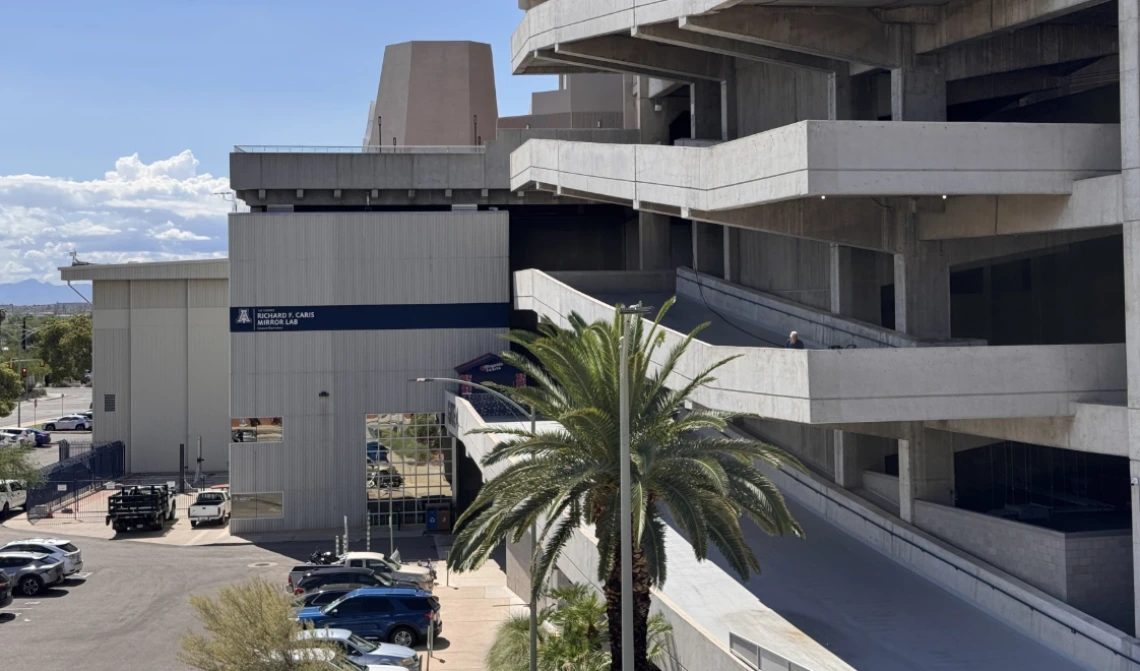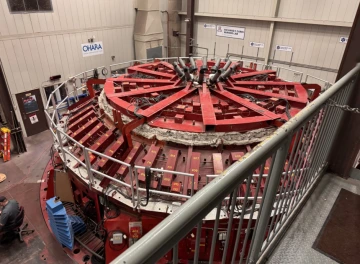Inside this stadium, UA is making large mirrors for the most powerful telescope to to be built

External view of the Richard F Caris Mirror Lab built inside and extending out of Arizona Stadium in Tucson.
Greg Hahne
Earlier this year, the Vera C. Rubin Observatory in Chile released its first images taken of deep space, with one picture capturing about 10 million galaxies. Getting those kinds of images requires telescopes with really, really large mirrors capable of gathering the necessary amount of light.
The only place in the world making those mirrors is right here in Arizona.
Will Clodfelder is with the University of Arizona’s Steward Observatory, the research arm of the UA Department of Astronomy in Tucson. He’s showing me around the Richard F. Caris Mirror Lab.
“You are currently underneath some of the bleachers of the stadium," Clodfelder said.
The lab is actually attached to the UA football stadium, with some parts being below seats and extending eastward. There’s a giant red furnace below, and scaffolding holds up a 28-foot wide circular mirror.

Furnace that melts the mirrors in the lab. It can be built to different sizes and spins to give the mirrors their shape.
Greg Hahne/KJZZ
“We are standing on the third story balcony. That's on the ground floor. It's still taller than us," Clodfelder said.
Manufacturing incredibly large mirrors this close to Wildcat action sounds like a recipe for disaster. But Clodfelder says it’s actually a great spot.
“Football stadiums tend to have large electrical grids as well. We knew we were going to have to have that for our furnace because it is an electric furnace. And of course, being on campus was convenient as well. So this was actually a pretty good place to build this, even if it seems like an odd choice," Clodfelder said.
The furnace is where they melt the glass for the mirrors and it can expand or contract depending on how big a mirror needs to be. And the furnace spins to create the slight bowl-like shape of the mirror necessary to focus all the light it gathers into a single spot.
“You want to try to collect as much light as possible. Think of a telescope as like a light bucket, right? Imagine you have a five-gallon bucket versus a swimming pool in a rainstorm. Which one's going to have more water at the end of the day?" Clodfelder said,
That means the telescope will be able to see incredibly deep into space with precise detail.
This singular mirror we are looking at is just one that has been cast for another observatory in Chile, that, when all is said and done, will be 83 feet wide.
“We can't transport a mirror that big, and we don't know how to cast one that big," said Buell Jannuzi, director of the Steward Observatory.
“The Giant Magellan Telescope uses seven circular mirrors that come together sort of like a flower, where you have one mirror in the middle and six petal mirrors around the outside," Jannuzi said.
And the mirrors need to be really smooth in order to get the images right. So the team works to get all the bumps down to be smaller than even the size of the COVID-19 virus.
So what exactly does this get you?
“You can actually see volcanoes on the surface of Io, one of the moons of Jupiter," Jannuzi answered.
The telescope will be 200 times more powerful than today’s best telescopes.
The GMT is set to be a sort of companion to the Vera C. Rubin Observatory. While Rubin is designed to make a large survey of the night sky for the next decade, GMT will zero in on faraway objects like exoplanets or galaxies for greater detail.
“You basically have a movie of the night sky for 10 years. So you can see things like the asteroids that move, stars that explode as supernovas, stars that collapse and go dark because they become a black hole," Jannuzi said.
“Objects that are discovered by Rubin, a supernova that goes off, follow it up with GMT," Jannuzi said.
How this technology came to be produced in Arizona goes back to the Cold War.
“The path that ended up leading to these mirrors came in some sense out of fear and concern and then moved into something else," Jannuzi said.
The mirrors are effectively hollow. Each has a singular reflective surface backed by a honeycomb structure that allows for insulation so temperature changes don’t interfere with observations.
This lightweight design can be traced to plans for the Manned Orbiting Laboratory.
“That was going to have giant binoculars to monitor the Soviet Union," Jannuzi said.
Crews would have landed on the space station orbiting Earth which would have those mirrors as part of binoculars for reconnaissance.
The project never took off.
“But the mirrors had already been made," Jannuzi said.
A previous director of the Steward Observatory convinced the government to send those mirrors to Arizona. They were eventually used on the telescope at Mount Hopkins between Tucson and Nogales as the first observatory to use more than one mirror on a telescope.
The story wasn’t unclassified until relatively recently.
“We didn't really have a whole story until 2015. All we knew when I was a grad student here in the '80s, all we knew is that these mirrors had become available," Jannuzi said.
The giant mirrors once designed for surveillance and monitoring people on earth were repurposed, turned around, and ended up providing incredible views of the cosmos.
And now the Giant Magellan Telescope is expanding on that concept. It recently made it to the final design phase at the National Science Foundation. Its first mirror was cast in 2005.
That’s why Jannuzi compares this process to building cathedrals.
“The reason I sometimes call the work we do at the mirror lab cathedral building is, and it's true for the larger telescopes that take a long time to build, is that like a cathedral, the people that are building it are not the ones that are going to be using it when it's completed," Jannuzi said.
The mirror lab started some 40 years ago, and GMT is still 10 years out.
“Like a cathedral, a human effort to try to understand ourselves through trying to understand the universe around us," Jannuzi said.
And what has Jannuzi come to learn about himself after all this time?
“I'm very, very interested in a wide, diverse set of questions, because I find the questions intrinsically interesting, but also I like the process of trying to figure out how we're going to try to answer them. It's not like I suddenly had some profound insight by seeing that one image into my true nature or something like that. It's more that I'm happy that I did make a choice to work in a field where I enjoy the actual process as well as what we're trying to do…you need to enjoy the process," Jannuzi said.
